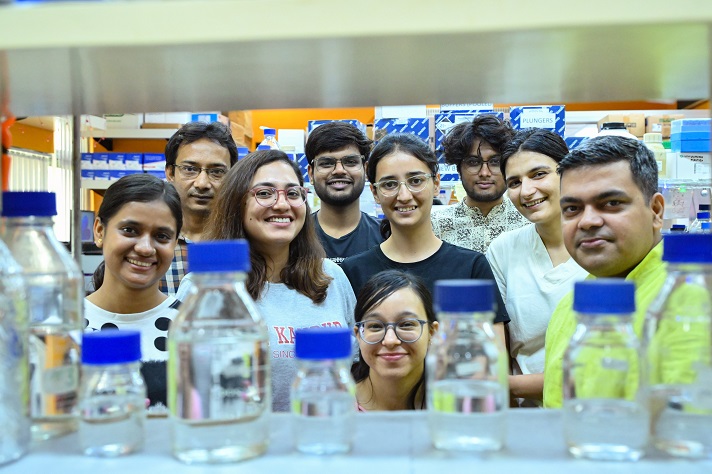Kanpur, 01 Aug, 2024: A research team from the Indian Institute of Technology Kanpur (IITK), led by Prof. Arun K. Shukla of the Department of Biological Sciences and Bioengineering, has made a significant scientific breakthrough with the first-ever visualization of the complete structure of the Duffy antigen receptor. This receptor protein, found on the surface of red blood cells and other cells in the human body acts as a gateway into the cell, facilitating infections by destructive pathogens like the malaria parasite, Plasmodium vivax and the bacterium, Staphylococcus aureus. 
The research paper on the discovery, published in Cell, a peer-reviewed prestigious scientific journal, will arm scientists working in the field of antimicrobial drug resistance with new information to further their research. Given the rising challenges of drug-resistant infections, the visualisation of the structure of the Duffy receptor will pave the way for further research into novel therapies for drug-resistant malaria and Staphylococcus infections as well as infections like HIV. Prof. Arun K. Shukla, Department of Biological Sciences and Bioengineering at IIT Kanpur said, “For years, researchers around the world have been trying to unravel the secrets of the Duffy antigen receptor, given its role in acting as a ‘gateway’ to help bacteria and parasites attack our cells and cause disease. Our success in finally visualizing this receptor at a high resolution will help us understand how pathogens exploit it to infect the cells. The knowledge will support the designing of next-generation medicines including new antibiotics and antimalarials, especially at a time when we are facing escalating antimicrobial resistance.” “While the Duffy antigen receptor is common in most populations, a significant percentage of people of African descent do not produce the Duffy receptor on their red blood cells due to a genetic variation. This makes them naturally resistant to certain types of malaria parasites that rely on that specific ‘gateway’ to infect those cells. This shows how important the Duffy antigen receptor is for these diseases and how targeting it could lead to new treatments,” added Prof. Shukla. The research team led employed state-of-the-art cryogenic-electron microscopy (cryo-EM) to unveil the intricate architecture of the Duffy antigen receptor, throwing new light on the Duffy receptor's unique structural features and distinguishing it from similar receptors in the human body. This detailed understanding will be crucial in the designing of highly targeted therapies that can effectively block infections without causing unwanted side effects. Prof. Manindra Agrawal, Director, IIT Kanpur said, “This remarkable achievement by our team of researchers is one more laurel in IIT Kanpur’s crown of achievements, pushing the boundaries of scientific knowledge. The success of this researchwill enhance our understanding of infectious diseases and help develop therapies for drug-resistant pathogens. This is a result of IIT Kanpur’s support to cutting-edge research that addresses real-world problems and solidifies our standing on the global scientific stage.” The research team included Shirsha Saha, Jagannath Maharana, Saloni Sharma, Nashrah Zaidi, Annu Dalal, Sudha Mishra, Manisankar Ganguly, Divyanshu Tiwari, Ramanuj Banerjee, and Prof. Arun Kumar Shukla from IIT Kanpur. In addition, the team also included researchers from CDRI Lucknow, Zurich in Switzerland, Suwon in Republic of Korea, Tohoku in Japan, and Belfast in United Kingdom. This research was funded primarily by the Department of Biotechnology (DBT), Department of Science and Technology (DST), Science and Engineering Research Board (SERB), DBT Wellcome Trust India Alliance, and IIT Kanpur. Read the full paper at : About IIT Kanpur: Indian Institute of Technology Kanpur was established in 1959 and declared to be an Institute of National Importance by the Government of India through an Act of Parliament. IIT Kanpur is best known for the highest standard of its education in science and engineering and seminal R&D contributions over the years. The institute has a sprawling lush green campus spread over 1050 acres with large pool of academic and research resources spanning across 19 departments, 25 centers and 3 interdisciplinary programs in engineering, science, design, humanities, and management disciplines with more than 580 full-time faculty members and approximately 9000 students. For more information, visit . | 
|
Drugs Against Infectious Diseases
- Thread starter dailyeducation
- Start date
